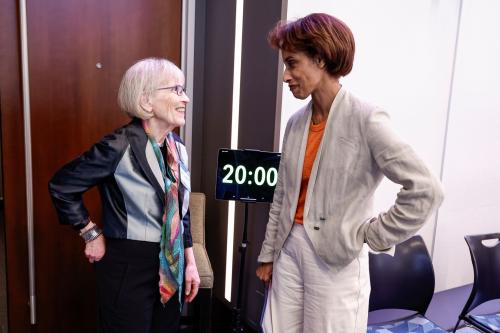Introduction
As the U.S. population ages and the baby boom generation approaches their 80s, policymakers face two critical challenges. First, the solvency of key old age support programs—Social Security and Medicare—is in jeopardy. Second, there is a serious and growing inadequacy of direct care workers in occupations such as certified nursing assistants, home health aides, and personal care aides.
These twin challenges will require the use of multiple policy levers if they are to be addressed. Revenues will need to be raised, benefits will not be sustainable at their current levels, and caregiving will become a bigger part of government and personal budgets. But the hard choices that need to be made can be somewhat ameliorated with smart immigration policy reforms. Immigrants can help address workforce challenges and are a net positive to the financial health of the Social Security and Medicare systems.
A series of proposed changes and their rationale are detailed below. The key elements are as follows:
Pillar 1: Provide immigration pathways for direct care workers.
Pillar 2: Enact general increases in permanent and temporary immigration caps.
Pillar 3: Address key flaws in the current immigration system.
Pillar 4: Adequately fund the immigration bureaucracy.
The demographic imperative
Like many countries, the U.S. has an aging population. People are living longer over the decades despite COVID-era setbacks; it is projected that by 2060, life expectancy will have increased six years to more than 85. At the same time, fertility has declined below replacement levels, with the Congressional Budget Office (CBO) projecting that the fertility rate will remain between 1.67 and 1.70 over the next several decades. The result of these forces is a striking change in the old-age dependency ratio—the number of working-aged people ages 18-64 per older adult ages 65 and up—decreasing from 5.7 in 1970 to 3.7 in 2020. The ratio is expected to fall to 2.7 by 2040. The demographic shift puts pressure on the financing of the Social Security and Medicare systems and the workforce to meet the direct care needs of the older population. The Social Security Administration (SSA) projects that the Social Security trust fund will be depleted by 2033, and industry groups project that the U.S. will need almost 2.5 million more direct older adult care workers in 2040.
A partial solution includes policies to promote and expand legal immigration. Immigrants help the U.S. meet its demographic challenge in several ways. First, many immigrants tend to come to the United States as young adults; 61% of new permanent residents fall in the 15 to 44 age range. This means they have many years to contribute to the economy and to the Social Security system before becoming beneficiaries of that system. Second, though fertility is declining among immigrants as well as the U.S.-born, immigrants tend to have more children than the average U.S.-born person.
These factors mean that immigration is critically important to population growth. In a hypothetical scenario with no further migration, the U.S. Census Bureau projects that the nation’s population would decline from 333 million today to 314 million in 2050. For more realistic scenarios, the 2050 population projections range from 345 million to 384 million depending on immigrant inflows. In other words, the future population growth of the United States hinges on immigration levels.
The current immigration landscape
Roughly 14% of the U.S. population was born outside the United States. This is similar to the high level that existed in the golden age of immigration around 1900 but is lower than some similar countries such as Germany (17% ), Canada (23% ), and Australia (29.5% ). Within the U.S., the share foreign-born ranges from 2% in West Virginia to 27% in California. The optimal level of immigration is a matter of significant policy debate, but the experience of some states and countries suggests that an immigrant population substantially higher than the one we have now could be successfully managed.
The primary policy lever for influencing migration flows is the dauntingly complex legal migration system. Legal permanent (“green card”) immigration to the United States averages around 1 million per year,1 a figure which includes both newly arriving immigrants and those who transition from a temporary or undocumented status into permanent residency. Migration of immediate relatives (parents, spouses, and dependent children of U.S. citizens) is not subject to numerical limits and represents about 46% of all flows,2 and permanent residency through humanitarian pathways is also not subject to direct Congressional control. But most other legal migration pathways are managed through numerical caps that Congress determines and has not been updated in more than three decades despite the fact that the size of the economy has doubled.
Green cards are available for relatives of U.S. citizens and permanent residents with numerical caps depending on the familial relationship. Further restrictions limit disproportionate arrivals from any given country. An average of 640,0003 people gain legal permanent resident status through capped and uncapped family-based pathways each year. In the capped categories, there are significant backlogs of 3 to 17 years depending on the familial relationship. Certain nations and categories have much longer waits; for example, the green card process is currently being finalized for Mexican nationals who are the married adult children of U.S. citizens and who first applied in 1998.
There is also a smaller employment-based set of pathways to permanent migration, with numerical caps totaling 140,000 per year. Most employment-based green cards require a sponsoring employer to go through a lengthy process called permanent labor (PERM) certification to prove that there are not sufficient American workers available to fill a position, a process that can take a year or more. However, employers hiring for selected positions on a list known as Schedule A—nurses, physical therapists, and those with exceptional ability—are able to bypass this part of the process. Schedule A was last significantly updated in 1991 so the two occupations on the list do not reflect the only or most severe areas of shortage. However, the Department of Labor is currently considering reform to the process for generating the list.
Recipients of employment based green cards are often highly educated workers already in the U.S., having entered through a temporary “dual intent” employment program like the H-1B visa. There are virtually no permanent employment-based pathways for immigrants without higher education or specialized skills. Backlogs are severe in the employment-based green card pathways for selected nationalities because of the 7% per-country cap. Indian nationals who first applied in 2012 are currently being processed, and the expected wait time for a skilled worker from India applying today is much longer.
Of course, legal permanent residents are not the only migrants in the United States. There are temporary visa holders, including students, tech workers, agricultural workers, tourists, and others. There are a substantial number who lack an official admission visa but entered with permission to plead an asylum case or under a humanitarian parole program. And there are about 11 million immigrants in the United States without any legal status, who typically overstayed a temporary visa or crossed the Southern border surreptitiously. Though some suggest that would-be immigrants “wait in line,” there are virtually no pathways for permanent legal migration for those with neither close family ties in the United States nor a college degree. And even with close ties, it takes years of waiting to get to the front of the line.
The caps of 226,000 for non-immediate-family-based migration and 140,000 for employment-based migration were last adjusted in 1990. Since then, the U.S. population has grown by 35% and the economy has grown by 123% . The National Immigration Forum estimated that stabilizing the dependency ratio through 2060 would require increasing immigration by about 37% .
Though immigration can be a polarizing issue, there is fairly broad consensus in support of expanding employment-based migration. Reforms have been stymied because of disagreement about other areas of immigration policy such as border enforcement and relief for the undocumented population. The result is a legal migration system which is woefully out of date and fails to meet the needs of the U.S. economy.
Direct care workers
About 6 in 10 adults over the age of 85 report some limitation in their activities of daily living, and many of them require support from a human being to meet their daily needs. The number needing assistance is projected to grow as more people reach their 90s and beyond, and as more Americans suffer from chronic conditions. There are an estimated 4.6 million direct care workers including nursing assistants or aides, home health aides, and personal care aides. Immigrants are disproportionately represented in direct care occupations, and increasingly so. About a quarter of all direct care workers are foreign born.
It is estimated that more direct care workers will be needed in the next decade and beyond. The Bureau of Labor Statistics projects 3% employment growth in the average occupation 2023-2032, but 22% for home health and personal care aides, with about 700,000 openings projected annually. One 2017 estimate from MIT researcher Paul Osterman predicted a shortfall of 151,000 paid direct care workers by 2030 and 355,000 workers by 2040. Chronic shortages have been exacerbated by the pandemic. More than half of nursing homes surveyed in 2022 reported that they limited new patient admissions due to nursing shortages. Even if U.S.-born participation in this occupation can be stabilized, there will still be a severe need for direct care workers as the population ages.
Economic research supports the critical importance of immigrants in the care workforce. Immigrants are important to nursing home staffing and quality of care. They also reduce flows into nursing homes by facilitating aging in place of U.S.-born older adults through their employment as home health aides. (Immigrants are also disproportionately represented among doctors, and could continue to help address chronic shortages in nursing.)
Immigration policy is not the sole avenue to address the direct care workforce challenges. Medicaid reimbursement rates could be raised to allow for higher wages, for example—this would attract new workers into the industry and reduce turnover, although potentially drawing workers out of other critical fields like child care. New technologies may also facilitate remote support for older Americans, perhaps requiring additional training for direct care workers. Even with these changes, however, there will not be a sufficient workforce to meet the needs of older adults. The proposal below aims to increase the capacity of the workforce to meet tomorrow’s direct care needs.
The Social Security system faces a solvency crisis. It is mostly a “pay-as-you-go” system in that payroll taxes from current workers support current retirees. There is also a trust fund to finance the Social Security benefits of the unusually large cohort of retirees in the Baby Boomer generation (born 1946-1964, who turn 62—the earliest claiming age for those without disabilities—between 2008-2026). The Old-Age, Survivors, and Disability Insurance (OASDI) trust fund is expected to deplete in 2034, at which point there will only be enough funds coming into the system to cover about 75% of promised benefits. Over the 75-year projection window, the Social Security actuaries project a shortfall of 3.61% of taxable payroll, and the CBO suggests a deficit of 5.1% . To square the circle, more revenues need to be raised or benefits need to be cut. Similarly, the 2023 Medicare report suggests that the hospital insurance(HI) trust fund will be depleted in 2031 and the 75-year actuarial deficit is 0.62% of taxable payroll.
Immigrants contribute to both systems. Immigrants with permanent status and dual intent temporary visas are subject to the payroll tax which finances Social Security and Medicare. In addition, some undocumented immigrants work in formal sector jobs using a false Social Security Number; in 2013 it was estimated that the contributions to the Social Security system without a corresponding beneficiary totaled $13 billion. Temporary immigrants without a pathway to permanent status, such as seasonal workers, do not pay into the system.
Of course, many long-term immigrants are recipients of Social Security after they have contributed. On net, however, immigration is a fiscal positive for the Social Security system over a 75-year horizon. In their 2023 report, the Social Security Trustees estimate a 75-year Social Security shortfall of 3.61% of taxable payroll under their midline immigration assumptions. But that number fluctuates from a 3.21% with a high immigration scenario to a 4.02% deficit in the low immigration scenario.
Proposed changes
Immigration can help ameliorate the twin challenges of an aging population and Social Security insolvency. Though there are many potential areas of improvement for the immigration system, here we focus on several that are particularly relevant to these challenges. We organize the reforms around four pillars: immigration pathways for direct care workers, general increases in migration caps, addressing other serious flaws in the current system, and funding the immigration bureaucracy.
Pillar 1: Provide immigration pathways for direct care workers
- Add direct care workers (including occupations such as certified nursing assistants, home health aides, and personal care aides) to Department of Labor Schedule A “shortage occupation” list. This would streamline permanent employment-based visas for workers in these fields.
- Introduce a new H-1D visa for direct care workers. The H-1D would be a dual intent visa for direct care workers, meaning visa holders would be eligible to apply for permanent residency. The cap would be 10,000 workers per year upon passage in FY25, then increasing by 3% per year starting in FY26. Like the H-1B program, workers would be sponsored by an employer for three years with the potential for a one-time renewal and the possibility of applying for a green card. Unlike the H-1B program, they would be eligible for Medicaid. H-4 derivatives (spouses and dependent children) would be approved for these workers without caps. The automatic annual growth of 3% would be suspended if the old-age dependency ratio (adults ages 18 to 64 divided by adults ages 65 and up) exceeds 3.6.
Under current law, there are few pathways for foreign-born direct care workers to come to the United States. Temporary workers generally either need a college degree (H-1B) or need to come to meet a one-time need or seasonal work (H-2A and H-2B). Because it is not typically the case that direct care work is needed on a one-time temporary or seasonal basis, these visas are not very helpful. A J-1 visa can be used for au pairs, and some have suggested folding direct care work visas into this program, but the temporary nature of these visas and the requirement that recipients return home after a year make it less than ideal for an occupation facing chronic shortages and in which the caregiver’s relationship with the client is quite important.
A better solution is a dual intent temporary visa. We propose a new H-1D program that would serve as a pathway in the direct care workforce. Modeled on the H-1B visa, employers would petition for workers to come to the U.S. for three years, renewable for a second term. H-1D visa holders would eventually be able to petition for permanent residency. The initial annual cap for this visa would be 10,000 (with uncapped family derivatives) to make substantial progress towards closing the gap in the direct care workforce.
Recognizing that workforce needs will continue to grow, the H-1D cap would rise annually by 3% by default. However, if demographic projections prove untrue and the old age dependency ratio returns to its 2020 level of 3.6, the automatic increases would be suspended. This could happen if there were unexpectedly large gains in fertility, unexpectedly high mortality at old ages, or unexpectedly high levels of migration.
In addition to the new visa category, the Department of Labor could facilitate direct care worker inflows by including these occupations on Schedule A. Currently, direct care workers could enter through the EB-3 category, but because the occupations are not on Schedule A, employers are required to go through an onerous Department of Labor PERM certification process. The Schedule A list of occupations has not been significantly updated since 1991. Updating the list to reflect current labor market conditions, including needs in the direct care workforce as well as a range of other sectors, is an obvious fix that has been proposed by the Bipartisan Policy Center and others.
The Department of Labor is actively considering processes that would allow for regular updates to the schedule. The Institute for Progress (IFP) suggests following the example of the United Kingdom and creating a weighted index using data on income, unemployment, labor force participation, vacancies, and changes in employment to determine which occupations are at risk of a labor shortage. This would create a systematic way to identify occupations where supply is not meeting demand and provide an avenue for immigrants to fill in the gap. Implementing a system based on labor market conditions would “future-proof” Schedule A against the inaction of Congress. By applying the IFP formula, Schedule A would be expanded to include a wide variety of care professionals including surgeons, diagnostic technicians, counselors, and audiologists, all of which will become increasingly important as the U.S. population ages. Though the preferred formula proposed by the IFP does not currently yield direct care workers as the highest priority workforce need, the principle of using a data-driven approach to Schedule A is a good one.
Pillar 2: Enact general increases in temporary and permanent immigration caps
- Increase permanent employment-based migration caps (EB-1 through EB-5) by 50% (i.e., increase the cap from 140,000 to 210,000) in FY26. Then increase by 3% per year from there starting in FY27 and continue to raise the cap by 3% annually thereafter. This annual growth provision would be suspended for any time period in which the old–age dependency ratio (adults ages 18-64 per adult 65 and over) exceeds 3.6.
- Increase other major permanent migration caps by 1.5% per year annually starting in FY26 (1.5% increase in F-1 through F-4 family preference visas as well as current 226,000 minimum for family preference combined, 1.5% increase in diversity visas), so all caps would slowly increase over time. This annual growth provision would be suspended for any time period in which the old–age dependency ratio (adults ages 18-64 per adult 65 and over) exceeds 3.6.
- Increase major temporary employment-based caps by 50% in FY26 (H-1B and H-2B). From there, increase by 3% per year starting in FY27 and continue to increase in the years following. Increase new H-1D direct care workers by 3% per year starting in FY26, as noted above. This annual growth provision would be suspended for any time period in which the old–age dependency ratio (adults ages 18-64 per adult 65 and over) exceeds 3.6.
The goal of a general increase in permanent and temporary immigration caps is to foster population and economic growth. We propose substantial increases in the employment pathways because these changes are particularly conducive to long-run growth and have broad political appeal. The reform is structured as a large one-time increase of 50% in employment-based migration followed by continued growth at a small rate. The permanent employment increases would not substantially change the number of workers in the U.S. economy in the short run because most of the allocation of green cards would go toward the substantial backlog of workers already in the U.S. on temporary visas. Over time, the backlog would diminish. The increase in temporary employment caps would immediately increase flows of H-1B and H-2B workers; the H-1B workers directly contribute to Social Security revenues and many will eventually obtain green cards as the backlog is cleared.
We also recommend instituting small annual increases in all legal immigration by default, with the caps going up by 1.5% or 3% each year. As the economy continues to grow, it is reasonable to think that immigration inflows should follow suit. History suggests that Congress is unlikely to make regular updates to immigration limits; we “future-proof” against Congressional inertia by making small regular increases. However, if projections about the old-age dependency ratio prove to be erroneous and the old-age dependency ratio exceeds its 2020 level, the automatic annual increases would be suspended.
Of course, Congress could always take action to raise or lower the limits if it is later determined these levels are not meeting American needs, or could decide to tie annual increases to other economic markers.
Pillar 3: Address key flaws in current immigration system
We propose implementing key provisions of the bipartisan Dignity Act (H.R. 3599, introduced in 2023) that are barriers to addressing workforce and solvency issues. These are:
- Status adjustments for “Dreamers”/Temporary Protected Status holders as described in Dignity Act, and Dignity program for other undocumented immigrants with pathway to conditional permanent resident status.
- Visa backlog for selected categories maxes out at 10 years, at which time green card is granted and not applied to caps. We propose this should apply to F1, F2A, and F2B family preference categories, as well as all EB permanent employment visa categories. This would reduce the very long wait times for immigrants from specific countries.
- Do not count derivatives (spouses and children) against employment-based visa caps.
There are many dysfunctional elements of the current immigration system, and this proposal does not attempt to fix all of them. However, there are a few changes that could go a long way towards promoting economic growth and the solvency of the social security system. The first of these is a program to regularize the status of several groups: “Dreamers”, described in the 2023 Dignity Act as those who entered the U.S. as minors and are pursuing (or have completed) secondary education, Temporary Protected Status holders who have often lived in the U.S. for many years, and other undocumented immigrants. Allowing these groups to have a long-run status with permission to work will encourage investment in human capital and work in the formal sector, both of which facilitate Social Security solvency.
The 10-year limit on the green card visa backlog would allow workers to come in from countries with a particularly high number of applicants for family immigration, such as Mexico. Under the proposed provision, unmarried adult children of citizens or permanent residents and dependent children of lawful permanent residents would not need to wait more than ten years for family reunification. Siblings and married children would still be subject to potentially long wait times to avoid unintentionally large family-based flows.
Under the reform, employment-based applicants also would be able to obtain a green card after ten years, addressing the significant backlogs currently faced by Indian nationals working in the U.S. The spouses and children also would not count against the caps, effectively opening more opportunity for employment-based green cards. These provisions would allow the U.S. to take advantage of the desire of many skilled professionals to live in the U.S. and contribute to the economy.
Pillar 4: Adequately fund the immigration bureaucracy
Backlogs are severe in nearly every part of the immigration bureaucracy. Some of these backlogs are directly created by restrictions on legal migration. For example, the very long backlog in employment-based permanent residency for those from India stems from the fact that the annual and per-country caps are much lower than the number of temporary workers who wish to make a permanent home in the United States. The issue is similar for non-immediate relatives of U.S. citizens; those seeking to immigrate from Mexico that are the highest family preference face a backlog that is only now processing applications from April of 2005. Other backlogs stem from inadequate staffing and infrastructure, leading to slow processing times for applications. The Bipartisan Policy Center has estimated that clearing the full queue of green card backlogs arising from the caps and the processing backlogs would generate trillions of dollars in economic activity.
The backlogs are not just in green card processing. As of October 2023, there were 1.6 million applications for employment authorization sitting in the queue. Immigration courts recently hit a backlog of 3 million cases as of December 2023. The many migrants arriving at the border have diverted resources, which were already inadequate, away from the regular administration of immigration law.
Implementing the changes proposed here will require substantial additional investment in the immigration bureaucracy to allow the legal immigration system to function more smoothly.
Conclusion
The solvency of Social Security and Medicare is in jeopardy. Policymakers will need to make some hard decisions within the next decade to minimize cuts to the programs. Immigration policy cannot fully solve this challenge, but expansions in immigration can assist in addressing the shortfall. The Social Security Actuary estimated that the proposed 2013 immigration reform bill would have solved about 8% of the 75-year Social Security shortfall, for example. Additionally, income tax derived from new immigrants would decrease the federal budget deficit overall. CBO estimated the proposed 2013 bill would have decreased the deficit by 197 billion over the 2014-2023 period. Immigration policy can also help grow a labor force of certified nursing assistants, home health aides, and personal care aides that will be critical as the population ages.
Policymakers should not overlook immigration policy as one key component of the solution to U.S. fiscal challenges.
-
Acknowledgements and disclosures
The author would like to acknowledge Simon Hodson and Chloe Zilkha for research assistance, and Wendell Primus, Richard Frank, Sherry Glied, and Jack Smalligan for helpful comments.
The Brookings Institution is financed through the support of a diverse array of foundations, corporations, governments, individuals, as well as an endowment. A list of donors can be found in our annual reports published online here. The findings, interpretations, and conclusions in this report are solely those of its author(s) and are not influenced by any donation.
-
Footnotes
- Author’s calculation based on averages of 2014-2022 fiscal years, as reported in Table 6 of the 2022 Yearbook of Immigration Statistics.
- Ibid.
- Ibid.







Commentary
How immigration reforms could bolster Social Security and Medicare solvency and address direct care workforce issues
April 16, 2024